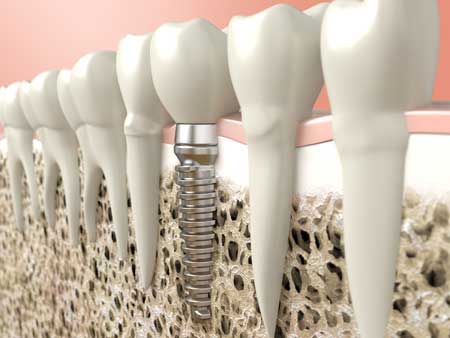The material the implants are made of is entirely biocompatible with the body tissues. It is similar to the material of the implants orthopedic doctors use in orthopedic surgeries. Thus, it is characterized as a safe and resistant material of high quality and purity that is supposed to remain in the oral cavity for a lifetime. Due to their material and way of manufacture, the dental implants reach very high success rates (over 95%).However, this also depends on the correct design of the treatment plan, the quality of the implants, the experience of the doctor and the patient’s cooperation. The excellent oral hygiene by the patient and the regular monitoring by the dentist ensure the maintenance of the implants for life.
A necessary condition for the placement of dental implants is to have enough volume of jaw bone to support the dental implants. If this condition is not met then, we can increase the dimensions of the jaw bone by using bone grafts. At Dental Group we perform surgical procedures to augment the thickness and the height of the jaw bone, as well as sinus lift procedures.
In any case, the candidate for dental implants should be in good general and oral health. Poor oral hygiene, smoking and serious health problems such as uncontrolled diabetes, can reduce the high success rates of dental implants.
- to replace a missing tooth without grinding down the adjacent teeth
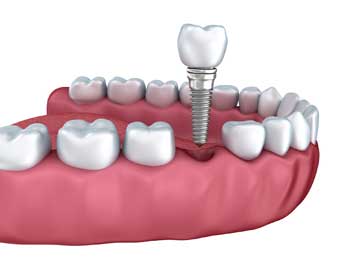
- to replace, with fixed bridges, missing teeth in order for the patient to avoid having a removable denture.
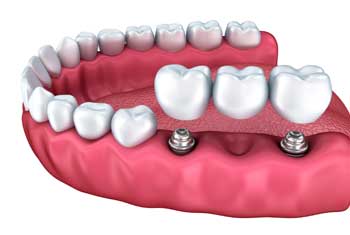
- to support a fixed detachable denture. This denture is not removable, it is supported permanently and entirely by the implants and hence does not have flanges and does not cover the roof of the mouth (palate).
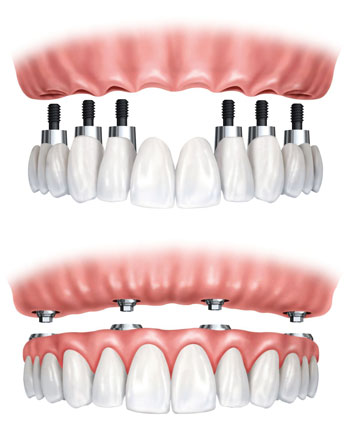
- to support a fixed detachable denture. This denture is not removable, it is supported permanently and entirely by the implants and hence does not have flanges and does not cover the roof of the mouth (palate).

- Preservation of adjacent teeth
With the use of the dental implants the adjacent teeth do not need to be grinded down as happens with the placement of a dental bridge. In this way, implants do not weaken the adjacent teeth and the risk of caries is reduced.
- Avoidance of a removable denture
Through the use of the dental implants fixed dental bridges can be constructed and thus the patient can avoid a removable denture.
- Excellent aesthetic result
Restorations on dental implants can achieve an excellent aesthetic result without being distinguished from the natural teeth. Furthermore, dental implants can prevent bone loss which may alter the facial features of the patient.
- Confidence boost
Dental implants provide to the artificial teeth the necessary support and stability while chewing or speaking. This boosts the patient’s confidence and frees the patient from the insecurity of using a denture.
- Reliability
According to long-term scientific studies and clinical research, the success rate of implants is very high, more than 95%. They are considered by the dental community as a reliable option for the replacement of one or more teeth.
- Easy oral hygiene practise
The oral hygiene practises applied around a dental implant are usually easier than the ones required under a dental bridge.
- Lower long-term cost
Even though the initial cost is higher than that of a small dental bridge, in the long term this difference may be reversed. Patients who are prone to caries may be obliged to replace a dental bridge in the future or may be led to undergo additional and costly operations, such as endodontic treatment (root canal).
In addition to good oral hygiene, the patient should visit regularly his dentist in order to monitor the implants and have them cleaned.
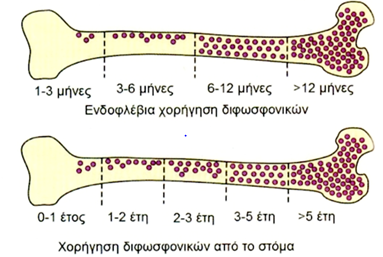
Accumulation pace of bisphosphonates into the bone after long term oral or intravenous intake (modified image by Marx 2007)
A critical side effect of bisphosphonates intake is the possible necrosis of the bone of the jaw (osteonecrosis). In this case, when the bone of the jaw gets exposed to the oral environment, i.e after tooth extraction, or after periodontal surgery, or after implant placement, necrosis of the bone may occur resulting in the poor healing of the wound area. Usually, proper treatment of osteonecrosis resolves the problem, however there are cases where necrosis expands and treatment becomes challenging.
Although bone necrosis is a severely unpleasant side effect of bisphosphonates intake, its occurrence is very rare and depends upon the amount of the drug that has accumulated in the bones. Thus, its risk is considered to decrease dramatically in patients that receive bisphosphonates orally for a period of less than 5 years or intravenously for less than 3 years. In these patients implant placement is not contraindicated, although some prevention measures may be recommended, in order to further reduce the risk for osteonecrosis.
Consequently, it is important that the patient, informs the dentist that he/she uses or used these medications. Hence, the dentist can take all necessary precautions and the patient can receive detailed information about the risk of implant placement.
Dental implant placement procedure
Before the placement of a dental implant, the surgeon evaluates the patient’s medical and dental history and takes the necessary radiographs, in order to assess if there is enough volume of bone to support the implant. After this important diagnostic phase, the surgical placement of the implant follows.
Initially, local anesthesia is delivered so that the patient does not experience the slightest discomfort during the placement of the implant.
Then, a small incision is made in the gums to expose the jaw bone. By this way, the dentist gains access to create a small hole in the jaw and screw the implant. The size of the hole depends on the type of the implant that is going to be placed. Additionally, depending on the type of implant, this can be buried under the gums during the integration phase or barely protrude above the gums. Finally, the wound is secured with small sutures.

The duration of the surgery, always depends upon the case, but in simple cases it usually lasts 30 minutes and is totally painless. Any discomfort after surgery, can be treated with mild pain-killers and it is recommended to prescribe antibiotics. After the surgery, the dentist gives instructions regarding the diet and proper oral hygiene practices.
After just one week, the patient comes back, to remove the sutures. The procedure is very simple and does not require anesthesia.
Usually, within 2-3 months the implants get integrated with the jaw bone and implant restoration (crown, bridge, etc.) can start.
Immediate implant placement after the tooth extraction
The placement of a dental implant immediately after the extraction is feasible. However, it is avoided when the socket that remains in the jaw after extraction of a tooth is larger than the dimensions of the implant. In this case the implant doesn’t have the initial stability needed in order to integrate with the jaw bone and there is an increased risk for the implant to fail.

Implant placement and restoration at the same day
The placement of a dental implant and the prosthetic restoration on the same day (immediate loading) are feasible. This kind of procedure is used, mainly, in order to minimize the duration of the overall treatment and is applied according to a specific protocol.
Immediate loading of the implant is, typically, avoided because it increases the risk for implant failure. Specifically, the chewing forces exerted on the restoration of the implant may cause micromovement to the implant which may not integrate with the jaw bone during the healing phase.

In order to avoid this situation, a temporary restoration is constructed in a way that it does not interfere with the implant, but at the same time it solves the functional and aesthetical problems created by the missing teeth. After the integration of the dental implants, the construction of the final restoration is completed.
Implant placement when there isn't enough bone volume (bone grafts)
Many times, the bone of the jaw has been resorbed at the region that the tooth was lost, resulting in inadequate bone quantity for the placement and support of a dental implant. This problem can be solved through the use of bone grafts.
These grafts are available in the market or they can be harvested from other parts of the jaw of the same patient. With the bone grafts we can preserve or even increase the dimensions of the jaw, both in height and width.
Another common problem for implant placement in the upper posterior jaw region is when the sinus has descended to a low level in the jaw. In these cases, the sinus has to be elevated with a procedure called sinus lift. Sinus lift, depending upon the case, may occur either simultaneously with implant placement or prior to implant placement. In the latter case, the patient will have to wait approximately 6 months until new bone has formed in the area where the sinus was elevated and then have the implants placed.
Although most of the bone defects can be restored with bone grafts, it should be noted that their success depends, largely, on the anatomy of the bone defect as well as and on the general health and cooperation of the patient. Thus, the decision of using bone grafts is determined case by case.
Socket preservation
Normally, after tooth extraction the bone of the jaw in that region gets resorbed, and hence the jaw bone becomes thinner. This change in bone dimensions may impair implant placement or affect the aesthetics of the future restoration.


In order to avoid such unpleasant situations, after the atraumatic extraction of a tooth the socket is filled with a bone graft material. This graft will minimize bone resorption and will facilitate the formation of new bone in the socket.
Ridge augmentation
Multiple teeth loss can lead to an extensive resorption of the jaw bone which may create large bone deficiencies. This alteration in bone dimensions may prevent implant placement or may induce aesthetic problems to the future restoration.


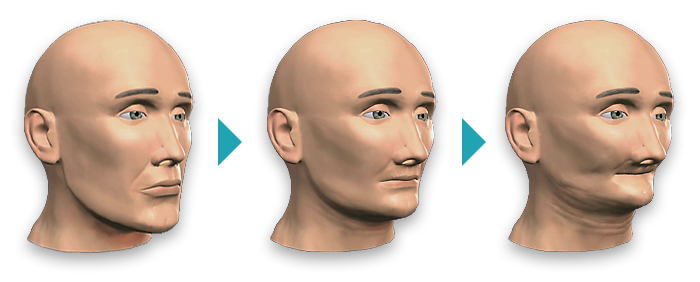
In these cases, the reconstruction of the jaw bone with bone grafts is necessary prior to implant placement. It is reasonable, that the more extensive the defect the more challenging the grafting procedure may become.



Maxillary sinus elevation
The sinus is an airway cavity, like a balloon, located at the posterior region of the upper jaw.
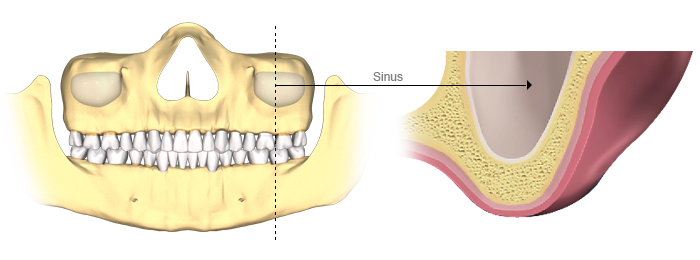
If the distance from the ridge of the jaw until the maxillary sinus is big enough, then an implant can be placed.

Sometimes, though, after the extraction of a posterior tooth, the sinus begins to move downwards due to the absence of the tooth root. Hence, the sinus starts occupying the space of the jaw where the root was. Thus, the placement of an implant in this region may not be possible, because the penetration of the sinus by the implant is not desirable.


To resolve this problem, we resort to a surgical procedure called maxillary sinus elevation. During this surgery, the periodontist, after having gained access to the maxillary sinus, moves it upwards and fills the empty space with a bone graft. Thus, new bone is formed again in the region and the implant can now be placed. The elevation of the maxillary sinus is done under local anaesthesia. The minor discomfort that the patient may experience post-surgically is treated with mild pain killers.


What is peri-implantitis
In order to preserve the tissues around the implants in a healthy condition, the patient needs to implement effective oral hygiene practices (brushing, flossing, inter dental brushes). Otherwise, bacteria of the dental plaque can accumulate around the implant, at the gingival margin, and cause inflammation. This inflammation can destroy not only the gums that surround the implant, but also the bone of the jaw that supports the implant in place. This unpleasant condition is called peri-implantitis and corresponds with the diseases of gingivitis and periodontitis that occur around the teeth. If peri-implantitis is left untreated it can destroy a large part of the supportive bone, resulting even in the loss of the implant.
The treatment of peri-implantitis is based on the removal of the bacteria around the implant. Depending on the case, a conservative or a surgical approach may be followed. However, unlike the smooth root surface of the teeth, the implants have a rough surface with threads that makes the removal of the bacteria challenging. Therefore, the outcome of the therapy is not always predictable. Finally, in some few cases a bone graft procedure may take place in order to rebuild the bone around the implants. However, again this procedure is not very predictable.
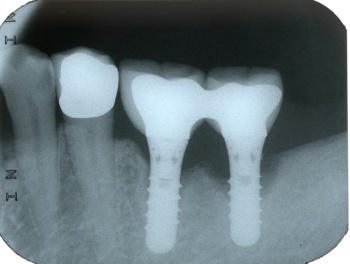
Consequently, prevention through effective oral hygiene and regular re-examinations at the dental office, is the best way to preserve the implants over time.
How long do dental implants last?
The implants are manufactured, to be kept for a lifetime. It is essential, though, that the patient has good general and oral health, has effective oral hygiene and complies with the periodic re-evaluation at the dental office.
Can an implant be rejected?
Dental implants are made of titanium which is absolutely, biocompatible with the body tissues. Thus, the implants are integrated into the bone of the jaw and essentially become part of the body. The literature reports that the implants have a very high success rate reaching 95-97%.
Although the human body does not reject a dental implant, this doesn’t mean that an implant can’t fail. However, the failure can be caused due to other factors, such as:
- poor oral hygiene
- incorrect surgical placement
- excessive loading on the implant
- the presence of systemic diseases, such as the uncontrolled diabetes etc.
How long do I have to stay away from work?
Because the implant placement procedure, most of the times, is not more complex than an extraction, patients generally don’t feel the need to take time off from their work.
Nevertheless, the patients are advised to avoid laborious tasks, that require intense physical exercise, during the same and the next day after the surgery.
Is there any discomfort during implant placement?
During implant placement the patient will have no pain or discomfort since the procedure is performed under local anesthesia
After surgery, the discomfort is similar to that after an extraction. Thus, by prescribing mild pain killers for one or two days, the discomfort is treated effectively. The provision of medication that prevent possible swelling is limited to more complex cases. It is also common practice, that the patient receives antibiotics for a few days after implant placement.
Why do missing teeth have to be replaced with dental implants?
Replacing the missing teeth is very important for the oral health as well as for the general health of the patient.
The consequences of not replacing missing teeth are many, such as:
- Difficulty in chewing
The missing teeth affect the chewing capability and consequently the quality of one’s nutrition and of life in general.
- Tooth migration
The neighbouring teeth move to the “empty” spaces affecting negatively the occlusion.
- Poor aesthetics
The absence of teeth can negatively affect aesthetics in two main ways: a) the gaps created from the missing teeth refer το a neglected mouth and b) in areas where the teeth are missing the jaw bone resorbs, resulting in the loss of the youthful facial structure.
- Speech problems
The problem in speech is particularly evident when the front teeth are missing.
What are the causes of teeth loss?
The loss of one tooth has adverse consequences for the oral and general health and for this reason it is recommended to have them replaced.
The most common causes of tooth loss are:
- dental caries
- periodontitis
- trauma

